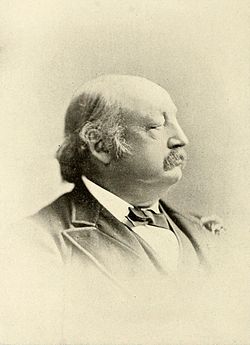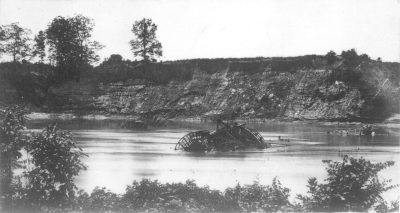 |
| Fort Fisher |
After many Union expeditions against the south, there was only one major port still in Confederate hands – Wilmington, North Carolina. In December, 1864 the Federals set out to close it, but first they had to capture Fort Fisher. A Union squadron under Rear Admiral David Porter was sent, along with an army under Benjamin Butler. The navy bombarded the fort on December 23, but it did little damage. Fort Fisher was built out of dirt, which absorbed the shock of the balls much better than masonry forts like Fort Sumter. Two days later Butler's army landed and began preparing to assault, but the entire expedition was called off when news arrived that a division of Confederate reinforcements was coming, and Butler called off the expedition, in direct disobedience to orders.
 |
| Butler |
Grant and Lincoln were upset by Butler's failure. Butler was a Democrat politician. Since Lincoln had just won reelection to the presidency he no longer needed the worry about the repercussions of punishing Butler. Therefore Butler was removed from command. 9,000 Federal troops were sent back to Fort Fisher, this time under the command of Major General Alfred Terry, who had experience in this type of warfare from the siege of Charleston. By this time the garrison of Fort Fisher was 1,900 strong. The 6,400 man strong division under Robert Hoke was stationed just north of the fort. These were all under the command of Major General W. H. C. Whiting. On January 13 the Federal infantry landed between Fort Fisher and Hoke's forces, which did not attempt to stop the landing.
 |
| Porter on one of his ships |
On January 15, 150 years ago today, the attack on the fort began. Terry and David Porter had developed a plan with good coordination between army and navy. The fight began with Porter's ships bombarding the Confederate works. They successfully silenced most of the Confederate guns. The a force of 2,000 sailors and marines landed it assault the fort's seaward face, while Terry's infantry attack and the land side. The assault of the navy troops was a failure. The plans for the marines to lay down a covering fire were not executed, and all of the Federals tried charging toward the fort's Northeast Bastion. From there the Confederate drove them back with heavy casualties.
 |
| Navy sailors attacking the fort |
This attack did draw the defender's attention away from the landward side. At 2:00 pm the Union division under Adelbert Ames charged forward. An advance part used axes to cut through the obstacles around the fort, while the rest of the troops followed close behind. Although many soldiers fell, shot by snipers on the wall, the Federals pushed forward and gained the interior of the fort. The fight, however, was still not over. Confederates still continued to resist, and the remaining guns on the seaward side were turned on the wall which had fell into Yankee hands. Whiting himself gathered some Confederate defenders and personally led a counterattack. It was driven back, and Whiting himself badly wounded. He would later die after the battle.
 |
| Federals attacking Fort Fisher |
The Federal assailants continued to push forward, driving back Confederate resistance. They were ably supported by Porter's ships, which continued to lob shells int o the fort. However, after hours of fighting, they still had not secured the fort. Both sides were behind defensive positions and the fighting raged on after sunset. Colonel William Lamb, the Confederate who was directly responsible for the fort's defenses, gathered what survivors he could to try to make a united counterattack, but he himself fell wounded. During the battle, Whiting had been send messages to department commander Braxton Bragg begging for more troops. Bragg did not believe the fort was in serious trouble, and instead sent Alfred Colquitt to relieve Whiting.

Soon after Colquitt landed at the fort, the situation began to deteriorate rapidly. The Federlas were determined to win the fort that night, and the Federals sent a flanking party outside the wall to strike the last pocket of Confederate resistance. This pressure was too much to bear. Colquitt and his staff realized what was happening, and hurried to escape in their rowboats. The rebels in the last traverse raised a white flag to announce the fort's surrender. At 10:00 pm the fort was officially turned over to the Federals.
 |
| A cannon in Fort Fisher, whose mussel was shot away during the battle |
This fort was one of the most fiercely contested during the entire Civil War. The casualties were high, but the number was increased even further when the fort's magazine exploded the next day, killing and injuring 200 Federal soldiers and Confederate prisoners sleeping on its roof. The losses from this battle were 1,341 Federals and 583 Confederate killed and wounded, with the rest of the garrison falling prisoner. With Fort Fisher in Union hands, Wilmington fell a month later. All of the major sea ports were now Federal hands.
 |
| USS Mahopac |















